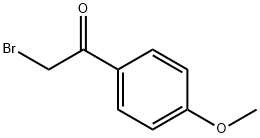|
ChemicalBook Optimization Suppliers |
| 名前: |
Alfa Aesar |
| 電話番号: |
400-6106006 |
| 電子メール: |
saleschina@alfa-asia.com |
|
| 化学名: | 4'-メトキシフェナシルブロミド | | 英語化学名: | 2-Bromo-4'-methoxyacetophenone | | 别名: | 1-(2-bromo-4-methoxyphenyl)ethanone;P-Methoxy-α-bromoacetophenone;ω-Bromo-4-methoxyacetophenone, 4-Methoxyphenacyl bromide;2-(4-Methoxyphenyl)-2-oxoethyl bromid;1-(4-Mehtoxyphenyl)-2-bromoethanone;1-(Bromoacetyl)-4-methoxybenzene;4'-Methoxy-α-bromoacetophenone;2-Bromo-4'-methoxyacetophenone,98% | | CAS番号: | 2632-13-5 | | 分子式: | C9H9BrO2 | | 分子量: | 229.07 | | EINECS: | 220-118-8 | | カテゴリ情報: | Protection & Derivatization Reagents (for Synthesis);Synthetic Organic Chemistry | | Mol File: | 2632-13-5.mol |  |
| 融点 | 69-71 °C(lit.) | | 沸点 | 215.8°C (rough estimate) | | 比重(密度) | 1.4921 (rough estimate) | | 屈折率 | 1.5500 (estimate) | | 貯蔵温度 | 2-8°C | | 溶解性 | Chloroform (Slightly), Methanol (Slightly) | | 外見 | Crystals or Crystalline Powder | | 色 | Off-white to light brown | | 水溶解度 | It is soluble in DMSO, water (partly miscible), most organic solvents, and methanol. | | BRN | 743112 | | InChI | InChI=1S/C9H9BrO2/c1-12-8-4-2-7(3-5-8)9(11)6-10/h2-5H,6H2,1H3 | | InChIKey | XQJAHBHCLXUGEP-UHFFFAOYSA-N | | SMILES | C(=O)(C1=CC=C(OC)C=C1)CBr | | CAS データベース | 2632-13-5(CAS DataBase Reference) | | NISTの化学物質情報 | Ethanone, 2-bromo-1-(4-methoxyphenyl)-(2632-13-5) |
| | 4'-メトキシフェナシルブロミド Usage And Synthesis |
| 外観 | 白色~うすい褐色、結晶~結晶性粉末 | | 用途 | 有機合成原料。 | | 化学的特性 | off-white to light brown crystals or | | 使用 | 2-Bromo-4'-methoxyacetophenone, is used as a cell-permeable, covalent and potent protein tyrosine phosphatase inhibitor. | | 使用 | 2-Bromo-4'-methoxyacetophenone is a α-haloacetophenone derivatives tested for inhibition of protein tyrosine phosphatases SHP-1 and PTP1B. | | 製造方法 | Obtained by reaction of N-bromosuccinimide (NBS) with 4-methoxyacetophenone in the presence of trimethylsilyl trifluoromethanesulfonate (TMS-OTf) in acetonitrile at r.t. for 24 h (87%). | | 生物活性 | ki: 128 μmptp inhibitor ii is a protein tyrosine phosphatase (ptp) inhibitor.protein tyrosine phosphatases (ptps) are reported to be involved in the etiology of diabetes mellitus, neural diseases such as alzheimer and parkinson diseases, regulation of allergy and inflammation, or ptps are even regarded to be responsible for the pathogens. | | in vitro | in a previous study, it was found that all of the previously reported ptp inhibitors contained a negatively charged, nonhydrolyzable py mimetic as the core structure, such as malonates, aryl carboxylates, phosphonates, or cinnamates. the poor membrane permeability of these inhibitors might compromise their potential development. it was reported that several α-bromoacetophenone derivatives, such as ptp inhibitor ii, could act as fairly potent ptp inhibitors, by covalently alkylating the conserved catalytic cysteine in the ptp active site. since ptp inhibitor ii is neutral, it could readily diffuse into human b cells and inhibit the intracellular ptps. the sar study was performed with the catalytic domain of phosphatase shp-1, and ti was found that ptp inhibitor ii showed time-dependent inactivation of shp-1, consistent with the mechanism. furthermore, the potency of ptp inhibitor ii was described by an equilibrium constant ki, representing the dissociation constant of the noncovalent enzyme–inhibitor complex. ptp inhibitor ii bound with lower affinity than ptp inhibitor i with ki values of 128 μm [1]. | | 参考文献 | [1] p. heneberg. use of protein tyrosine phosphatase inhibitors as promising targeted therapeutic drugs. current medicinal chemistry 16(6), 706-733 (2009). |
|